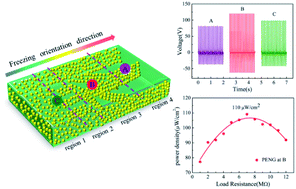Enhanced performance of piezoelectric composite nanogenerator based on gradient porous PZT ceramic structure for energy harvesting†
Abstract
Piezoelectric nanogenerators with the ability to convert mechanical energy into electrical energy for energy harvesting have prompted widespread concern. In this work, gradient porous PZT ceramics with a cellular region, transition region, progressive lamellar region and homogeneous lamellar region were prepared via freeze casting method. PDMS as a flexible matrix was introduced into the pore space of porous PZT ceramics to form piezoelectric composites. The gradient porous structure promoted the ability of stress transfer, and greatly improved the efficiency of electromechanical conversion. Among these regions, the PENG in the progressive lamellar region displayed the maximum optional electric output performance. The PENG generated the maximum output voltage of 152 V and current of 17.5 μA, which were 2 times and 1.6 times higher than those of piezoelectric composites with randomly dispersed PZT ceramic particles under the given external mechanical stress. The sensitivity of PENG based on the gradient porous PZT ceramics was 1.52 V N−1, which possessed a remarkable superiority in comparison with other PENG with 3D interconnected structure. Moreover, the instantaneous power reached 1.1 mW, which could light up 96 LEDs. This work demonstrated the potential application of porous piezoelectric composites in energy harvesting.



 Please wait while we load your content...
Please wait while we load your content...